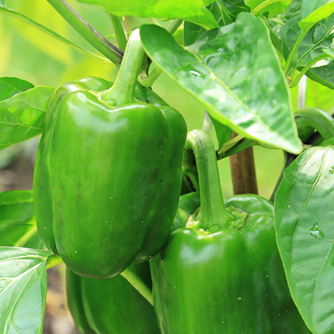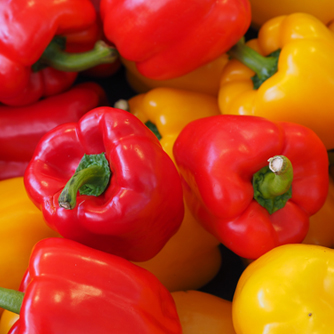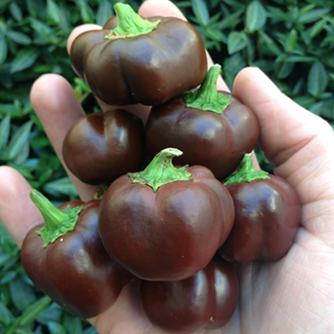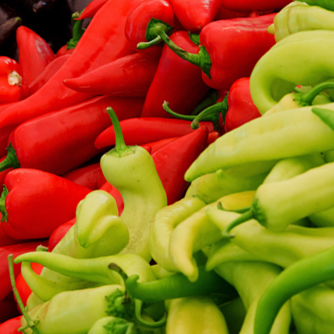Capsicums
BackCapsicums are an easy to grow vegetable that add colour and flavour to salads, stews and casseroles. They’re rich in Vitamin C and other nutrients and come in all shapes and sizes with a wide range of colours. Flavours range from sweet and mild to hot and spicy so there’s bound to be a capsicum that’s just right for you!
It might seem strange but capsicums are also related to tomatoes, chillis, potatoes and eggplants as they all belong in the Nightshade or Solanaceae family. Keep this in mind when rotating crops in your veggie patch.
How To Grow Capsicums
Select a location which receives full sun but protection from winds which can break stems. Capsicums perform best in fertile free-draining soil so enrich the soil beforehand with aged manure, compost and/or a certified organic fertiliser. It’s also important to boost calcium levels in the soil to help prevent blossom end rot later in the season. Increase calcium levels by adding dolomite or lime but keep an eye on the soil pH though to ensure it remains acidic (dolomite and lime increase pH). If your soil pH is already in the right zone then apply gypsum instead which adds calcium but without altering the pH.

Bell capsicums can be picked when green for a sharper flavour
Capsicums are commonly grown from seed or seedlings but sometimes you’ll also see small plants available at the nursery. Sow seeds in a tray or punnet first and plant out when they are about 10cm tall. Capsicums like to be planted into warm soil so in colder areas wait until the last frost has passed before you plant. Water in new plants with OCP eco-seaweed to help them settle in faster and then mulch around them.
Maintain regular, deep waterings throughout the growing period, especially during hot dry periods.
Sowing Guide for Capsicums
| Growing Zone | Sowing Time |
| Cool Zones | Spring |
| Mediterranean Zones | Spring, Summer |
| Warm & Temperate Frost Free Zones | All year round |
| Tropical & Subtropical Zones | All year round |

Red and yellow bell capsicums are left longer to ripen and taste sweeter
Fertilising and Harvesting Capsicums
Every couple of weeks apply a mix of OCP eco-seaweed and OCP eco-aminogro to strengthen plants, encourage growth and build natural resistance to pest and disease attack. Do not to use fertilisers that are very high in nitrogen as this causes the plants to produce an abundance of leaves with little fruit.
Halfway through the growing season reapply dolomite, lime or gypsum to ensure calcium levels in the soil are plentiful. Capsicums love calcium!
Capsicums are slow to develop fruit and can take up to 3 months depending on the variety chosen and your climate. All capsicums are green to start with before developing their full colour eg red, yellow, orange or purple. They can be picked early when green but the longer you wait the sweeter they will be.
Take care when harvesting fruit as the branches can be easily broken. Cut the stem with a knife or secateurs and leave a small stalk on the fruit. Pick regularly to encourage more fruiting.

These mini chocolate coloured capsicum variety are very sweet tasting
Pests and Diseases of Capsicums
Being in the same family as tomatoes, capsicums suffer from the same pest and disease problems so watch out for the following :
- Snails and slugs - young seedlings are vulnerable to these slimy pests so sprinkle around OCP eco-shield pellets after planting.
- Aphids, mites and whitefly – look out for these pests and spray OCP eco-oil at the first sign. Their numbers can multiply quickly and early control is important so they don’t get the chance to damage plants and spread diseases.
- Fruit fly – these troublesome flies lay eggs inside the fruit which hatch into maggots and ruin the fruit. Hang an OCP eco-lure trap at planting time to monitor their presence and then apply OCP eco-naturalure as soon as they appear. Fruit fly is becoming an increasing problem so be vigilant for this pest and act early.
- Caterpillars – there are some caterpillars that will attack the foliage and developing fruit. Pick off those you can see or read our guide for further tips on controlling caterpillars organically.
- Root knot nematodes – roots that have been attacked by these tiny pests will swell and develop multiple bumps or ‘knots’. Once damaged the roots are unable to efficiently take up moisture and nutrients causing stunted plant growth, reduced yields, regular wilting and early plant death. Prevent nematode build up by incorporating organic matter (compost and manures) when preparing your soil and practicing crop rotation.
- Blossom end rot – premature rotting of fruit, from the base, is due to a lack of calcium. This can be because there isn’t enough in the soil to start with (capsicums use up a lot) or the soil frequently dries out preventing the roots from being able to take it up. You can boost calcium levels with dolomite, lime or gypsum but it does take time for to become available to plants which is why we recommend adding at planting time. Mulch plants to conserve water and adjust your watering regime to maintain moist soils. Applying OCP eco-hydrate will help improve water penetration and retention.
- Powdery mildew – this common fungal disease grows as a white or light grey coating over the foliage. Act quickly to prevent its spreading by spraying with OCP eco-fungicide.
- Wilts and other diseases – there are quite a few other diseases (bacterial, fungal and viral) which can attack capsicums and are difficult or impossible to control once present. They can cause distorted and stunted growth and fruit, mottled leaves, wilting and plant death. Prevent these problems by controlling sap sucking pests (which can transmit some diseases) and practicing crop rotation (so diseases don’t build up in the soil). Avoid planting capsicums, chillis, tomatoes, potatoes and eggplant in the same spot year after year.
eco tip: Regular sprays every 2 weeks of a mix of OCP eco-oil, OCP eco-fungicide, OCP eco-seaweed and OCP eco-aminogro will encourage strong, healthy plants and prevent many of these problems.

Horn shaped capsicums are also quite sweet


